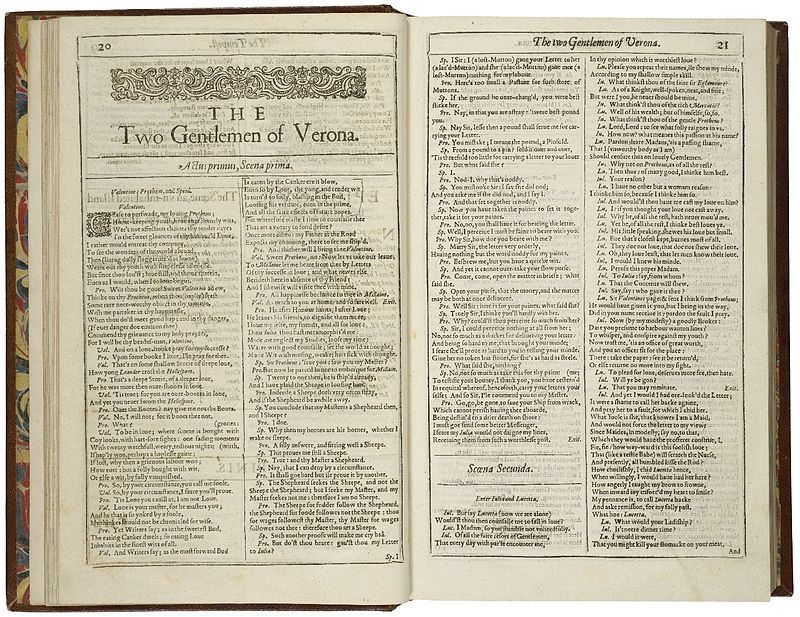The Two Gentlemen of Verona
The Two Gentlemen of Verona is a comedy by William Shakespeare, believed to have been written between 1589 and 1593. It is considered by some to be Shakespeare's first play, and is often seen as showing his first tentative steps in laying out some of the themes and motifs with which he would later deal in more detail; for example, it is the first of his plays in which a heroine dresses as a boy. The play deals with the themes of friendship and infidelity, the conflict between friendship and love, and the foolish behaviour of people in love. The highlight of the play is considered by some to be Launce, the clownish servant of Proteus, and his dog Crab, to whom "the most scene-stealing non-speaking role in the canon" has been attributed.
Two Gentlemen is often regarded as one of Shakespeare's weakest plays. It has the smallest named cast of any play by Shakespeare.

Date and text
Date
The exact date of composition of The Two Gentlemen of Verona is unknown, but it is generally believed to have been one of Shakespeare's earliest works. The first evidence of its existence is in a list of Shakespeare's plays in Francis Meres's Palladis Tamia, published in 1598, but it is thought to have been written in the early 1590s. Clifford Leech, for example, argues for 1592/1593; G. Blakemore Evans places the date at 1590–1593; Gary Taylor suggests 1590–1591; Kurt Schlueter posits the late 1580s; William C. Carroll suggests 1590–1592; Roger Warren tentatively suggests 1587, but acknowledges 1590/1591 as more likely.
It has been argued that Two Gentlemen may have been Shakespeare's first work for the stage. This theory was first suggested by Edmond Malone in 1821, in the Third Variorum edition of Shakespeare's plays, edited by James Boswell based on Malone's notes. Malone dated the play 1591, a modification of his earlier 1595 date from the third edition of The Plays of William Shakespeare. At this time, the dominant theory was that the Henry VI trilogy had been Shakespeare's first work. More recently, the play was placed first in The Oxford Shakespeare: The Complete Works of 1986, and again in the 2nd edition of 2005, in The Norton Shakespeare of 1997, and again in the 2nd edition of 2008, and in The Complete Pelican Shakespeare of 2002.
A large part of the theory that this may be Shakespeare's first play is the quality of the work itself. Writing in 1968, Norman Sanders argued "all are agreed on the play's immaturity." The argument is that the play betrays a lack of practical theatrical experience on Shakespeare's part, and as such, it must have come extremely early in his career. Stanley Wells, for example, has written the "dramatic structure is comparatively unambitious, and while some of its scenes are expertly constructed, those involving more than, at the most, four characters betray an uncertainty of technique suggestive of inexperience." This uncertainty can be seen in how Shakespeare handles the distribution of dialogue in such scenes. Whenever there are more than three characters on stage, at least one of those characters tends to fall silent. For example, Speed is silent for almost all of Act 2, Scene 4, as are Thurio, Silvia and Julia for most of the last half of the final scene. It has also been suggested that the handling of the final scene in general, in which the faithful lover seemingly offers his beloved as a token of his forgiveness to the man who has just attempted to rape her, is a sign of Shakespeare's lack of maturity as a dramatist.
In his 2008 edition of the play for the Oxford Shakespeare, Roger Warren argues that the play is the oldest surviving piece of Shakespearean literature, suggesting a date of composition as somewhere between 1587 and 1591. He hypothesizes that the play was perhaps written before Shakespeare came to London, with an idea towards using the famous comic actor Richard Tarlton in the role of Launce (this theory stems from the fact that Tarlton had performed several extremely popular and well known scenes with dogs). However, Tarlton died in September 1588, and Warren notes several passages in Two Gentlemen which seem to borrow from John Lyly's Midas, which wasn't written until at least late-1589. As such, Warren acknowledges that 1590/1591 is most likely the correct date of composition.


















0 comments
Sign in or create a free account